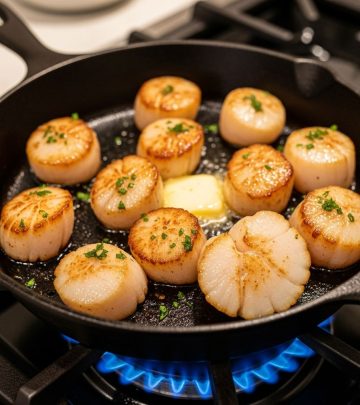How Long Does Garlic Last?
Understanding Garlic's Shelf Life and Storage Tips for Maximum Freshness

Introduction to Garlic Storage
Garlic is one of the most versatile and widely used ingredients in cooking, found in almost every cuisine around the world. Its shelf life and storage methods can significantly impact its flavor and aroma. Understanding how long garlic lasts and how to store it properly is essential for maintaining its quality and ensuring it remains safe to eat.
The longevity of garlic depends largely on its form and storage conditions. Here’s a breakdown of how long garlic lasts in different forms:
How Long Do Garlic Bulbs Last?
Whole garlic bulbs can last
3 to 6 months
when stored correctly. It’s crucial to keep them away from heat and humidity. The papery layers on the bulbs should be left intact as they help prevent moisture from reaching the cloves. Most commercially available garlic is of the softneck variety, but you might also find hardneck garlic, which has a long, woody stem in the center. For longer storage, it’s best to leave the stem in place.How Long Do Garlic Cloves Last?
If left in their papery shells, unpeeled garlic cloves can last about
3 weeks
. Keeping as much of their papery husks on the cloves as possible helps protect them from moisture.How Long Do Peeled Garlic Cloves Last?
Peeled whole garlic cloves should be refrigerated and will last about
a week
. While pre-peeled garlic is convenient, it’s important to use it quickly to avoid spoilage.How Long Does Minced Garlic Last?
Minced or chopped garlic will keep no more than
a day
when refrigerated. However, if submerged in oil, it can last up to2-3 weeks
when refrigerated, but it’s crucial to check for signs of spoilage regularly.How to Store Garlic
Proper storage is key to extending the shelf life of garlic. Here are some tips for storing garlic effectively:
How to Store Garlic Bulbs
Garlic bulbs store best in a cool, dry, dark place. Ideal locations include a pantry, cupboard, or a basement storage area. Temperatures between
15°C and 18°C
are optimal, but it’s more important to avoid areas near heat sources or direct sunlight.Airflow is crucial for garlic storage. Use ventilated containers like baskets, mesh bags, or paper sacks with small holes. Avoid plastic bags or sealed containers as they can trap moisture. Ceramic or terracotta garlic keepers can be a stylish and practical option for storing garlic on the counter, provided they are kept away from heat.
For those who use a lot of garlic, buying a decorative garlic braid can be practical. These braids consist of several heads woven together and can be hung in a cool, dry place, ensuring good airflow.
How to Store Peeled or Chopped Garlic
Peeled whole garlic cloves and chopped garlic should always be refrigerated. Store them in airtight containers to prevent their strong odor from affecting other foods in the fridge.
Garlic Stored in Olive Oil
Covering sliced or chopped garlic with a layer of olive oil can help preserve it longer and also yields a delicious garlic-infused oil. However, to avoid the risk of food-borne illness, the garlic and oil mixture must be refrigerated at
4°C
and used within7 days
.Recognizing Spoiled Garlic
Identifying spoiled garlic is important for food safety. Here are some signs to look out for:
- Off Odor: Fresh garlic has a pungent but pleasant aroma. Spoiled garlic often develops an unpleasantly strong or sour smell.
- Visible Mold: Check for any visible mold or mildew on the cloves or bulbs.
- Soft or Mushy Texture: Fresh garlic cloves are firm. If they become soft or mushy, it’s a sign of spoilage.
- Green Shoots: If garlic begins to sprout, it’s still safe to eat but may not be as flavorful.
Preservation Techniques for Garlic
Beyond storing garlic, there are several preservation methods that can extend its shelf life and create new flavors:
Dehydrating Garlic
Dehydrating sliced garlic can be done using a food dehydrator or by placing the slices in a low-temperature oven. The dried garlic can be stored in airtight containers for up to a year and rehydrated as needed.
Fermenting Garlic in Honey
Fermenting garlic in honey is a method that not only extends its shelf life but also creates a delicious and probiotic-rich condiment. Simply peel the cloves, place them in a jar covered with honey, and let it ferment in the fridge for several weeks.
Making Black Garlic
Black garlic is made by aging whole garlic bulbs at a controlled temperature and humidity. This process transforms the cloves into a sweet, umami-rich, jelly-like texture with increased antioxidant content. While it requires precise conditions, black garlic can be made at home with the right equipment.
Frequently Asked Questions (FAQs)
Q: How do I store garlic to prevent sprouting?
A: To prevent garlic from sprouting, store it in a cool, dry place. Avoid refrigerating whole bulbs unless you plan to use them quickly, as cold temperatures can trigger sprouting.
Q: Can I freeze garlic?
A: Yes, you can freeze garlic, but it’s best to do so after mincing or chopping it. Mix the minced garlic with a small amount of oil or water to prevent it from becoming too dry, then freeze it in ice cube trays for later use.
Q: Is it safe to store garlic in oil at room temperature?
A: No, it’s not safe to store garlic in oil at room temperature due to the risk of botulism. Always refrigerate garlic stored in oil and use it within a week.
Q: What is the difference between hardneck and softneck garlic?
A: Hardneck garlic has a central stem and typically produces fewer but larger cloves. Softneck garlic lacks this stem and produces more cloves, often storing better than hardneck varieties.
Q: How do I know if garlic has gone bad?
A: Check for signs of spoilage such as an off smell, visible mold, or a soft texture. If garlic begins to sprout, it’s still safe to eat but may lose flavor.












